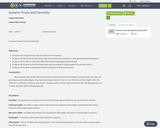
Lesson Plan Format Date: 1/29/18 Grade Level: 9th Concept: Genetic Traits and Heredity Objectives:Students will recognize that traits are inherited from parents.Students will demonstrate that sexual reproduction produces variation in their genotypes and phenotypes.Students will be able to define the difference between genotype and phenotype.Students will be able to predict the genotype and phenotype of offspring given the parents alleles.Students will be able to distinguish between dominant and recessive alleles.Introduction: We previously learned the difference between recessive and dominant alleles and how those can affect the genotypes and the phenotypes. Dogs have phenotypes based on the color of their fur and the length of their fur. Take into consideration that you have a litter of puppies with a mother dog that’s Brown with the genotype bb and a father dog that’s Black with genotype Bb. Vocabulary:Heredity—the passing on of physical or mental characteristics genetically from one generation to another.Dominate allele—An allele or a gene that is expressed in an organism's phenotype, masking the effect of the recessive allele or gene when present.Recessive allele—An allele that produces its characteristic phenotype only when it’s paired allele is identical.Genotypes—The genetic constitution of an individual organism.Phenotypes—The set of observable characteristics of an individual resulting from the interaction o its genotype with the environment.Homozygous—A set of alleles that are different from each other.Heterozygous—A set of alleles that are identical to each other.Punnett Square—A type of grid used to show the gametes of each parent and their possible offspring. Body of Lesson:As a class, I will provide the class two examples on the board and ask the class as one group to answer which square looks to be correct. Next I will ask the students to split into groups of two, I will give parent alleles and ask the groups to solve what the offspring’s genotypes and phenotypes will be. They will come to the board and put the answers that the group got. Finally on their own, using the alleles of the parent dogs, find what alleles, genotypes, and phenotypes of the puppies will be. The alleles for the fur color are B for the dominant allele and b for the recessive allele. Black fur is a dominant and brown is recessive. Using the parents from the introduction find the percentage for what the offspring will possible look like if the litter was composed of four puppies.Accommodations/Modifications:For ELL students I will have the paperwork printed in their native language. So they will get the instructions written in their language they understand best and I will ask them to write in English for their answers.For diverse learners I will provide different organisms or examples based on their background that I have gather through out the year to better relate the topic to the students. Examples if they have a cat I will explain to them that the animals can be cats instead of dogs.For different learning styles, depending on the type of learners in the classroom I will modify the lesson based on the amount of learners in my class. Such as if I have a lot of kinetic and visual learns I will use colorful cards to show the movement of alleles into the offspring, for auditory I will show them alleles pairing up in a video, and for reading/writing I will provide examples of the offspring on the board. For special need students I will provide the students with pictures with the letters instead of asking them to write it out. So that they will have a picture of the father dog with a Bb under it and a picture of the mother dog with a bb under it. I will also give them the alleles they can use to make the offspring and not ask them to make the alleles themselves. Assessment: Formative assessment: At the beginning of the lesson I will write out examples on the board and ask the class which example they thing is correct. After I think they have gotten the concept, I will ask them to split into groups and work together to figure out example and come to the board to show the class their answer.Summative assessment: The paperwork I hand out after each group has come to the board with the question about the parents having the litter of puppies will be done on their own in class. I will gather their papers at the end of class and grade for setting up the Punnett Squares correctly, putting the correct alleles in each spot, and for putting down the correct genotypes and phenotypes based off their gather alleles. Materials:Copies of worksheet (1 per group; containing the genotypes of the parent dogs a Punnett Square.)Slips of scratch paper (represent the alleles)Colored pencils, markers, or crayons (used to mark the paper for the alleles) Standard(s):SC12.3.2 Students will describe the molecular basis of reproduction and heredity.SC12.3.2.a Identify that information passed from parents to offspring is coded in DNA moleculesSC12.3.2.b Describe the basic structure of DNA and its function in genetic inheritanceSC12.3.2.c Recognize how mutations could help, harm, or have no effect on individual organismsSC12.3.2.d Describe that sexual reproduction results in a largely predictable, variety of possible gene combinations in the offspring of any two parents
- Subject:
- Life Science
- Material Type:
- Lesson Plan
- Author:
- Miles Englebert
- Brianna Williams
- Date Added:
- 01/29/2018
